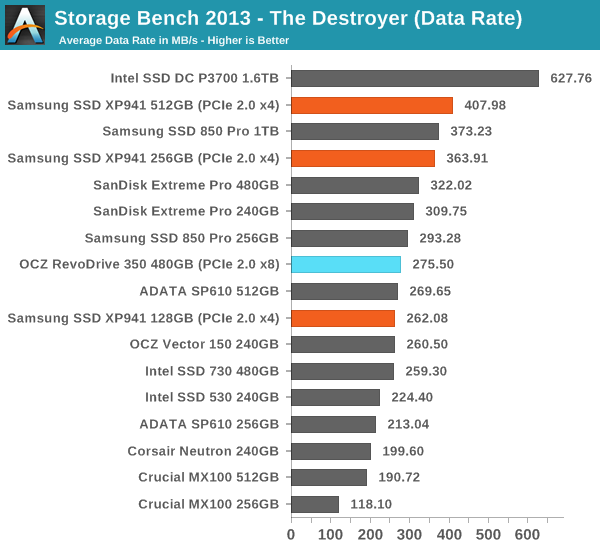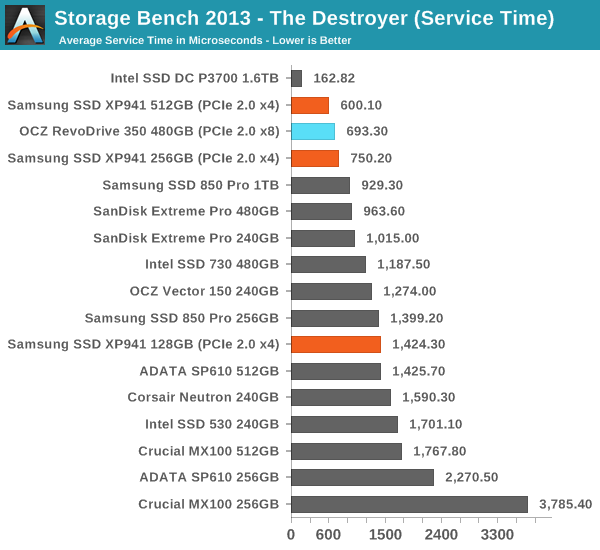PCIe SSD Faceoff: Samsung XP941 (128GB & 256GB) and OCZ RevoDrive 350 (480GB) Tested
by Kristian Vättö on September 5, 2014 3:00 PM ESTAnandTech Storage Bench 2013
Our Storage Bench 2013 focuses on worst-case multitasking and IO consistency. Similar to our earlier Storage Benches, the test is still application trace based – we record all IO requests made to a test system and play them back on the drive we are testing and run statistical analysis on the drive's responses. There are 49.8 million IO operations in total with 1583.0GB of reads and 875.6GB of writes. I'm not including the full description of the test for better readability, so make sure to read our Storage Bench 2013 introduction for the full details.
| AnandTech Storage Bench 2013 - The Destroyer | ||
| Workload | Description | Applications Used |
| Photo Sync/Editing | Import images, edit, export | Adobe Photoshop CS6, Adobe Lightroom 4, Dropbox |
| Gaming | Download/install games, play games | Steam, Deus Ex, Skyrim, Starcraft 2, BioShock Infinite |
| Virtualization | Run/manage VM, use general apps inside VM | VirtualBox |
| General Productivity | Browse the web, manage local email, copy files, encrypt/decrypt files, backup system, download content, virus/malware scan | Chrome, IE10, Outlook, Windows 8, AxCrypt, uTorrent, AdAware |
| Video Playback | Copy and watch movies | Windows 8 |
| Application Development | Compile projects, check out code, download code samples | Visual Studio 2012 |
We are reporting two primary metrics with the Destroyer: average data rate in MB/s and average service time in microseconds. The former gives you an idea of the throughput of the drive during the time that it was running the test workload. This can be a very good indication of overall performance. What average data rate doesn't do a good job of is taking into account response time of very bursty (read: high queue depth) IO. By reporting average service time we heavily weigh latency for queued IOs. You'll note that this is a metric we have been reporting in our enterprise benchmarks for a while now. With the client tests maturing, the time was right for a little convergence.

While the average data rates of the 256GB XP941 and RevoDrive are not that impressive, the average service times are. The average service time of the 256GB XP941 is nearly half of the same capacity 850 Pro and the RevoDrive too is faster than any SATA SSD, though the 512GB XP941 is still faster. The service time emphasizes high queue depth performance, which is often the stumbling stone for slower and cheaper drives, and that in turn increases their average service time.











47 Comments
View All Comments
xrror - Monday, September 8, 2014 - link
Not sure if this is technically possible, but I see a killer niche product of making a "generic bootable" NVMe PCIe card that presents whatever BIOS and/or uEFI code needed to bootstrap legacy systems with any M.2 or (possibly?) ajoining PCIe SSD of your choice?M.2 is obvious, just snap it onto the PCIe card.
I know in the old PCI days, some SCSI cards could boot ajoining cards for you also (Adaptec, LSI) but I was never sure that had to be vendor specific or not (probably).
Again it probably would take so much effort and be a compatibility hell, but I dunno, it would be nice.
Or we could get lucky, and bootable PCIe SSD's just take off as a common thing, so older systems can get into the game. Maybe...
GrigioR - Tuesday, September 9, 2014 - link
Yep, If they can make PCIe x4 or x8 cards that will translate into about 1000MB/s or 2000MB/s using PCIe 1.0/1.1 (bus speed). If you have some old board that have a second x4/x8 slot you could add one of these little things and still have a really fast system. Many good old boards have them and had support for 8GB DDR2 and quad core CPU's. So... you could still have a really fast system out of and old platform. (Phenon x4/Core2Quad/Modded Xeons).mohsin1994 - Monday, September 8, 2014 - link
very nice post :))www.gadgetsalert.com
Pwnstar - Monday, September 8, 2014 - link
Nice spam!MarcHFR - Thursday, September 11, 2014 - link
Hi,For secure erasing PCIe drive, what software did you use ? Thanks
dxv99p - Monday, January 12, 2015 - link
Today my XP941 256GB also died. I have not used any erase-tools. It died while PC was running idle with a bluescreen. My board is an ASRock z97 Extreme6. First I thought about the board or the power-supply but a test in another system confirmed it has gone after only 5 month in 24/7 running. Ambient temperatur is controlled at about 30°C so this is not the problem.andrewk18 - Monday, January 9, 2017 - link
Is there anyway to get the ocz revodrive 350 to work on mac pro 5,1?